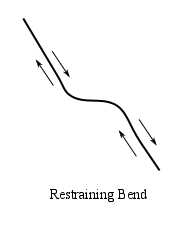Transpression

In geology, transpression occurs when a region of the Earth's crust experiences strike-slip shear and a component of shortening, resulting in oblique shear. Transpression typically occurs at a regional scale along plate boundaries characterized by oblique convergence. More locally, transpression can occur along strike-slip fault zones that are not perfectly planar. Many tectonic régimes previously defined as simple strike-slip shear zones are actually transpressional. It is generally very unlikely that a deforming body will experience "pure" shortening or "pure" strike-slip.
Transpressional shear zones are characterized by the co-existence of different structures, related to both strike-slip shear and shortening. End-member structures include pure strike-slip faults and pure thrust (reverse) faults. Faults that have components of both (termed "oblique" slip faults) are abundant. In addition, structures such as folds, tension fractures and Riedel shears all form in the shear zone, but at different angles to those observed in simple strike-slip fault zones.
Restraining bend

Restraining bends are transpressional structures that form where the orientation of a strike-slip fault becomes oblique to the regional slip vector causing local compression or uplift [1] They also form where two segments of a strike-slip fault overlap, and the relay zone between the segments experiences transpression. Restraining bends often form positive flower structures or pop-up ridges.
Transpressional regions
- Altai Mountains (Western Mongolia and Southern Siberia, Russia)
- Western Aleutian Subduction Zone
- Gobi Altai (Central Mongolia)
- "Big Bend" of the San Andreas Fault Zone, (California, USA)
- Alpine Fault in New Zealand
See also
References
- ↑ Christie-Blick, N. and Biddle, K.T. (1985). Deformation and basin formation along strike-slip faults in N. Christie-Blick and K.T. Biddle (eds.), Strike-Slip Deformation, Basin Formation and Sedimentation. SEPM Special Publications, 37.
Sanderson, David J. and Marchini, W.R.D. (1984) Transpression. Journal of Structural Geology, 6, (5), 449-458. (doi:10.1016/0191-8141(84)90058-0).